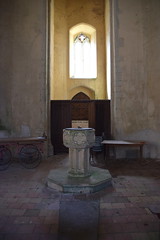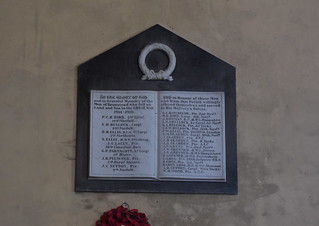| |
|
St Peter,
Brunstead Brunstead, also
known somewhat confusingly as Brumstead, is a small
parish without a village just to the north of Stalham on
the edge of the Broads. It largely consists of woodland
and narrow lanes, but is bisected by the busy Stalham to
Mundesley road. The first time I ever came here was with
the late Tom Muckley back in 2008. To be honest, we had
been looking for a pub. Oh, we also planned to visit St
Peter, because we knew it was somewhere in the area, but
both of us had left our OS maps at home, and so we
thought a gentle pint to collect our thoughts might be in
order. I knew that Ingham was also somewhere near, and
that the Woodforde's Brewery had recently taken on the
Swan Inn there, and so that seemed ideal. But while we
negotiated the narrow lanes, a rather handsome church
tower hove into view. It was grander than I expected, for
it must be said that Brunstead is not usually accounted
one of East Anglia's finer churches, but the setting is
lovely, up a farm track in the woods, with just the grand
pile of Brumstead Hall for company.
Coming back in June 2019 I once again came to a halt to
the west of the church, taking in its loveliness. There
was the Hall with the church beyond, the gardens
immaculate, the tower of the church rising behind them.
It was just about perfect, like something out of The
Go-Between. For a moment, it seemed as if I had been
transported back in time to before the First World War.
In 2008 we had found the church locked, most unusually
for this area, and I have to say I was rather looking
forward to getting the key again, for back then the
keyholder notice had directed me to the Hall. I had
wandered up the long drive, and coming towards me had
been an old fellow pushing a wheelbarrow. I kid you not,
he was the absolute spit of Paul Whitehouse's majestic
Ted character in The Fast Show. I asked him
where the key was, and he stopped, took his cap off,
wiped his brow, and said thoughtfully "Arh, the
missus is up in the conservatory". I can't do him
justice, he was splendid. I'd walked on, and a very nice
lady had given me the key. I looked into the Hall
grounds, but the gardener was now nowhere to be seen -
had I imagined him? Had it really happened? If I went for
the key would I still see him pushing that wheelbarrow up
the drive? However, much to my disappointment the church
was open.
The grand porch is of a piece with the tower. Sam
Mortlock notes that the style, unusually for Norfolk, is
early Perpendicular, while the body of the church is late
Decorated. This suggests that the church was built in
what was effectively one long campaign, punctuated by the
horror of the Black Death. I have to say that coming back
I found the church something of a contrast with the tidy
splendour of the Hall. The tussocky grass had obviously
been cut earlier in the year, but was unkempt without
being one of the churchyard conservation areas that were
common all across East Anglia this summer. The porch was
full of dead leaves from last year. A greening of moss
coloured part of the thatched roof of the porch, and
there was more moss and grass growing out of the brick
buttresses. There was a feeling of, not abandonment
exactly, but as if nothing much had happened here in the
eleven years since my last visit. As if, indeed, the
church had stood here all that time waiting for me to
come back. For a moment I shivered involuntarily in the
warm sunshine.
I had remembered the interior of St Peter as being almost
entirely early Victorian. There was a restoration in the
1830s and then another in the 1870s which had left what
Mortlock described in the 1980s as a bleak, bare
interior. Certainly, nobody would describe St Peter as
grand or lovely, but I remembered that there had been a
rustic simplicity to it, and that it had felt well-looked
after and loved. I turned the handle of the door, and
stepped down inside.
Even as my eyes became accustomed to the dim light I
could see that the story of outside was repeated within.
Dead leaves were scattered over the west end of the nave,
and a dead jackdaw lay on its back below the tower arch.
The green of damp was rising in the walls and through the
pamments of the brick floors. Over the benches there were
woven what seemed magical skeins of spiders' webs, like
something out of a fairy tale, as if the church were
asleep.
What had happened here? Or rather, what hadn't, for it
became clear to me that no one now cared for this church
in the way they had eleven years earlier, and perhaps
there was no one left who could, or at least who had the
means or will to do so. The church hadn't been abandoned,
it was clear that the occasional service still took place
here. It was more as if there had been a slow retreat,
what Matthew Arnold called a melancholy, long,
withdrawing roar. At the east end, St Peter and St
John, the work of the Norwich-based J & J King
workshop in the 1870s, look down seriously on this
silence. The same workshop's coloured quarries beneath
the tower cast an almost dream-like light over the 14th
Century font, sole survivor of this place's long medieval
generations. There is no electricity, and the oil lamps
that hang from the ceiling and rise from the benches echo
the age of the church's restoration perfectly.
It all made me feel a bit serious, if I'm honest. I
wandered around for a while finding things I remembered
from before. What a perfect setting, I thought, for
Brunstead's memorial to the dead of the Great War. I
don't recall ever seeing another one quite like it. In
white marble on black, an open book lies beneath a marble
wreath. The eight names of the lost boys are inscribed on
the left hand page, while on the right is the roll of
honour of twenty other boys who went to fight and were
lucky to come back. Almost a third of them lost, then,
about average for a rural English parish. Presumably most
of them worked for the Brumstead Hall estate. Their
surnames show the extended families typical of an
intensely rural parish at the start of the old century -
two Birds, four Bullocks, four Gladdens, three Grimmers.
It would be hard to imagine that you could find so many
young men living in the parish today.
Before leaving, I had another look at the memorial to
Charlotte Comyn, who died at the age of 73 in 1848. It
doesn't tell us much about her, other than that she was amiable
in person... and much respected for her good sense,
but it does mention that her husband Stephen was chaplain
to Lord Nelson, and was with him at the Battle of the
Nile and Copenhagen. I closed the door behind me,
and left them to their sleep.
Simon Knott, September 2019
Follow these journeys as they happen at Last Of England
Twitter.
 
   

|
|
|
